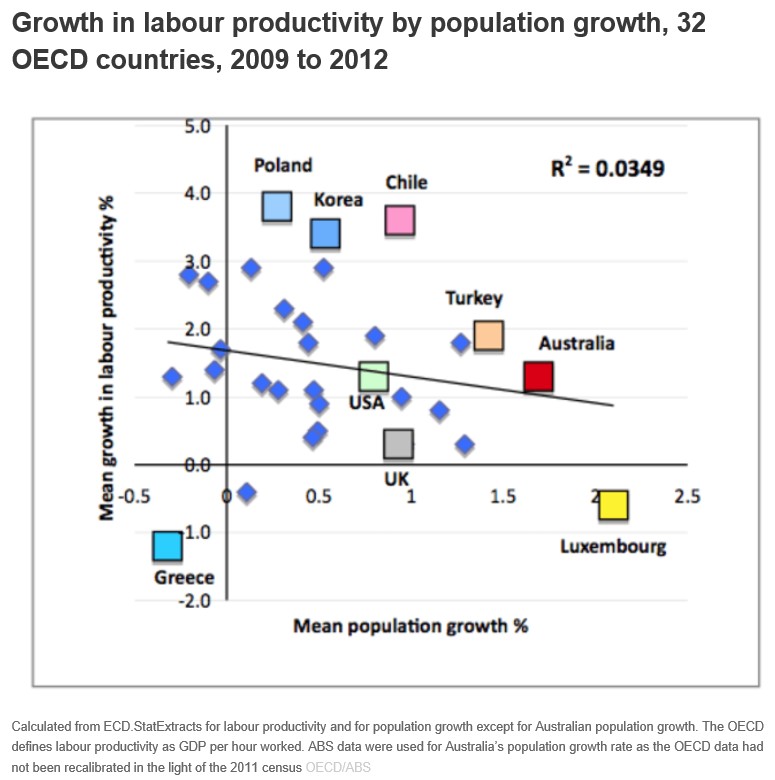In early 2003, I joined the Australian Treasury where I was immediately introduced to the Department’s “Three P’s” framework, which effectively argued that Australia needed to: 1) boost productivity; 2) raise workforce participation; and 3) increase the population via skilled migration, if the nation was to continue to enjoy rising living standards.
Being a young fella at the time, and fairly green in my thinking, I didn’t think too much about the framework and accepted it more or less as gospel.
Now in my late-30s, and arguably wiser, I have come to realise that only one of the Treasury’s pillars (raising productivity) is highly welfare enhancing, one is somewhat enhancing (lifting participation) and one (endless population growth) can be downright deleterious to living standards.
Life is all about trade-offs. Working more hours (increasing participation) can mean that less time is available for other pursuits, such as relaxing or meeting-up with friends. So while working more will, other things equal, raise incomes and GDP, it can also take away from the other pleasures in life, reducing its benefit.
No such problems occur with lifting productivity, which allows more goods/services to be produced (consumed) from less effort, and is the only real driver of rising living standards over the longer-term.
By contrast, population growth’s impact on living standards is highly questionable. While it certainly does raise headline GDP (more inputs equals more outputs), there are significant doubts over whether it raises per capita GDP, while also placing greater pressure on the environment, pre-existing infrastructure and housing, and Australia’s fixed endowment of mineral resources (see here for a detailed run-down of the issues).
Indeed, Katharine Betts, an Adjunct Associate Professor of Sociology at Swinburne University of Technology, has found that that data from 32 OECD countries show no statistically significant association between productivity and population growth:

Dr Betts has also called on Treasury to reduce the trifecta of the three Ps to a duo of productivity and participation:
…the deep shortcomings of GDP as a measure of well-being are now all too well known; for example the misery that commuters experience stuck in traffic shows up as a positive for GDP (more petrol consumed, more costly wear and tear on vehicles), and the GDP takes no count at all of the drag that the congestion imposes on productivity. In contrast the State of Australian Cities report predicts traffic congestion in the major cities will cost Australians A$20.4 billion a year by 2020 and stories of its ill effects on productivity are commonplace…
High immigration may have no effect on productivity, as the figure above shows, or as the Australian experience suggests, may reduce it. And it can be irrelevant to participation.
Thankfully, Australia’s policy makers finally seem to be heeding the call.
Back in March, current Treasury secretary, John Fraser, provided a lukewarm assessment of population growth via immigration [my emphasis]:
In recent years, Australia’s population growth has been amongst the fastest in the developed world, driven by migration.
A growing population can be a source of dynamism for the economy.
It provides a larger domestic market for business, increases the size of the labour force and facilitates the injection of new ideas.
But it also places additional demands on government budgets in areas such as infrastructure, health and education.
I have seen this firsthand in the United Kingdom where the results are very sobering.
And last month, RBA Governor Glenn Stevens took a veiled swipe at Australia’s high immigration program, endorsing a shift away from quantitative measures to boost growth, such as high immigration, to qualitative measures that improve productivity and living standards on a per capita basis.
Today, the National Reform Summit released its final statement, which included an entire section on the need to boost productivity and participation, but excluded any mention of the need for population growth (immigration) in order to improving living standards.
Hopefully, this omission represents a belated acknowledgement from Australia’s leaders and policy makers that high immigration is not an economic bonanza, and is in fact just as likely to damage the nation’s productivity and living standards.

